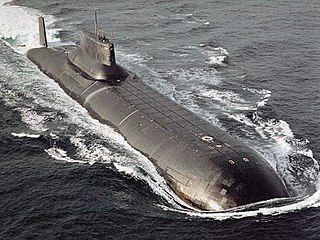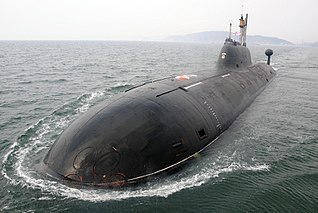
The Los Angeles class of submarines are nuclear-powered fast attack submarines (SSN) in service with the United States Navy. Also known as the 688 class after the hull number of lead vessel USS Los Angeles (SSN-688), 62 were built from 1972 to 1996, the latter 23 to an improved 688i standard. As of 2024, 24 of the Los Angeles class remain in commission—more than any other class in the world—and they account for almost half of the U.S. Navy's 50 fast attack submarines.

The Seawolf class is a class of nuclear-powered, fast attack submarines (SSN) in service with the United States Navy. The class was the intended successor to the Los Angeles class, and design work began in 1983. A fleet of 29 submarines was to be built over a ten-year period, but that was reduced to 12 submarines. The end of the Cold War and budget constraints led to the cancellation of any further additions to the fleet in 1995, leaving the Seawolf class limited to just three boats. This, in turn, led to the design of the smaller Virginia class. The Seawolf class cost about $3 billion per unit, making it the most expensive United States Navy fast attack submarine and second most expensive submarine ever, after the French Triomphant-class nuclear-powered ballistic missile submarines.

Silent Hunter is a World War II submarine combat simulation for MS-DOS, developed by Aeon Electronic Entertainment and published by Strategic Simulations in 1996. The game takes place in the Pacific War during World War II, the player commanding a submarine of the United States Navy. Most contemporary US submarines and Japanese warships are featured along with some generic merchant ships.

USS Seawolf (SS-197), a Sargo-class submarine, was the second submarine of the United States Navy named for the seawolf.
SUBSIM is an online publication founded by Neal Stevens in Jan. 1997 that focuses on naval and submarine computer game reviews, articles, and news. Subsim is short for Submarine simulator. Subsim's forums have been online since 1999, with archives back to 2001. Membership totals were 117,023 at August 2016, with approximately 7,700 active members daily. International meets have been held in London, Houston, Amsterdam, Copenhagen, Groton, Germany, and Tokyo.

688 Attack Sub is a submarine simulator video game designed by John W. Ratcliff and Paul Grace and published in 1989 for MS-DOS and in 1990 for Amiga by Electronic Arts. A Sega Genesis version developed by MicroProse was released in 1991 by Sega.

The Project 941 Akula, was a class of nuclear-powered ballistic missile submarines designed and built by the Soviet Union for the Soviet Navy. With a submerged displacement of 48,000 t, the Typhoons were the largest submarines ever built, able to accommodate comfortable living facilities for the crew of 160 when submerged for several months. The source of the NATO reporting name remains unclear, although it is often claimed to be related to the use of the word "typhoon" ("тайфун") by General Secretary Leonid Brezhnev of the Communist Party in a 1974 speech while describing a new type of nuclear ballistic missile submarine, as a reaction to the United States Navy's new Ohio-class submarine.

The Akula class, Soviet designation Project 971 Shchuka-B is a series of fourth generation nuclear-powered attack submarines (SSNs) first deployed by the Soviet Navy in 1986. There are four sub-classes or flights of Shchuka-B, consisting of the original seven Project 971 boats, commissioned between 1984 and 1990; six Project 971Is, commissioned between 1991 and 2009; one Project 971U, commissioned in 1995; and one Project 971M, commissioned in 2001. The Russians call all of the submarines Shchuka-B, regardless of modifications.

SSN is a techno-thriller novel, created by Tom Clancy and Martin H. Greenberg and published on December 1, 1996, as a tie-in to the video game of the same name. It follows the missions of USS Cheyenne, a United States Navy nuclear attack submarine, during a fictional war between the United States and China over the Spratly Islands. SSN is the second Clancy novel after Red Storm Rising (1986) that is not set in the Ryanverse.
SSN-21 Seawolf is a submarine simulator game designed by John W. Ratcliff and published for MS-DOS systems by Electronic Arts on April 3, 1994. A 3DO Interactive Multiplayer version was planned but never released.

Dangerous Waters, also known as S.C.S. Dangerous Waters, is a 2005 naval warfare simulation game developed by American studio Sonalysts Combat Simulations. It was released for Microsoft Windows in 2005, and on Steam on February 7, 2006.

An SSN is a nuclear-powered general-purpose attack submarine. SSN is the US Navy hull classification symbol for such vessels; the SS denotes a submarine and the N denotes nuclear power. The designation SSN is used for interoperability throughout NATO under STANAG 1166, though navies use other terms.

Silent Steel is a 1995 submarine simulator computer game by Tsunami Games. It was created during the influx of interactive movies during the 1990s. The game is composed almost entirely of live-action full motion video, with sparse computer-generated graphics depicting external shots of the boat during torpedo attacks and atmospheric fly-bys. A version playable on DVD players was released in 1999, following from a DVD-ROM version in 1997. The DVD-ROM version was the first video game formatted for DVD.

Fleet Command, previously labelled as Jane's Fleet Command, is a real-time tactics naval warfare simulation computer game released in May 1999. It was developed by Sonalysts Inc. and published by Electronic Arts (EA). The game licensed parts of Jane's Information Group's military information database, which was used as an in-game "Jane's Library", reference material that the player could refer to while in-game. Jane's also licensed to EA the "Jane's" name and the "Jane's Combat Simulations" logo, and the game was marketed under the "Jane's" name, much like the previous "Jane's Fighters Anthology", also published by Electronic Arts.

The Yasen class, Russian designations Project 885 Yasen and Project 885M Yasen-M, also referred to as the Graney class, are a series of nuclear-powered cruise missile submarines designed by the Malakhit Marine Engineering Bureau and built by Sevmash for the Russian Navy. Design work commenced in earnest in the 1980s with the first submarine built in the 1990s–early 2010s with commissioning in 2013. Two additional boats to an upgraded Yasen-M design were commissioned in 2021 and six more are under construction. Based on the Akula class and Alfa class designs, the Yasen class is projected to replace the Russian Navy's current Soviet-era nuclear attack submarines. The Akula class is optimised for a hunter-killer role, whereas the Yasen class concept uses the platform as a nuclear guided missile submarine (SSGN).
USS Seawolf is a naval thriller published in 2000 by best selling author Patrick Robinson. It is the fourth book to feature Arnold Morgan as a main character. The second edition was published in 2005 with a new cover picture painted by Larry Rostant.

Red Storm Rising is a simulation video game based on Tom Clancy's 1986 novel Red Storm Rising and released in 1988 by MicroProse. The player is put in charge of an American SSN submarine in the Norwegian Sea Theater with the overall role of a hunter killer performing various missions in the context of the global conflict described in the book representing a campaign. Its original Commodore 64 version was co-designed and co-programmed by the famous game designer Sid Meier.

Nerpa is a 8,140-tonne (8,010-long-ton) Project 971 nuclear-powered attack submarine. The construction of the submarine was started in Russia in 1993, but was suspended due to lack of funding. India then sponsored further construction and sea trials of the submarine provided it was leased to the Indian Navy for 10 years. It was launched as K-152 Nerpa in October 2008 and entered service with the Russian Navy in late 2009. The submarine was leased to the Indian Navy in 2011 after extensive trials, and was formally commissioned into service as INS Chakra with the Eastern Naval Command at a ceremony in Visakhapatnam on 4 April 2012. In June 2021 Chakra was spotted on the surface escorted by Indian and Russian warships in the Singapore Strait while presumably heading towards the Russian naval base in Vladivostok; some media speculated that she was returning to Russia before the expiry of the lease term.

Tom Clancy's H.A.W.X. 2 is an arcade-style combat flight simulator video game developed by Ubisoft Bucharest and published by Ubisoft. It is the sequel to Tom Clancy's H.A.W.X, and was released for Xbox 360 and PlayStation 3 in September 2010, and for Wii and Microsoft Windows in November 2010.
















